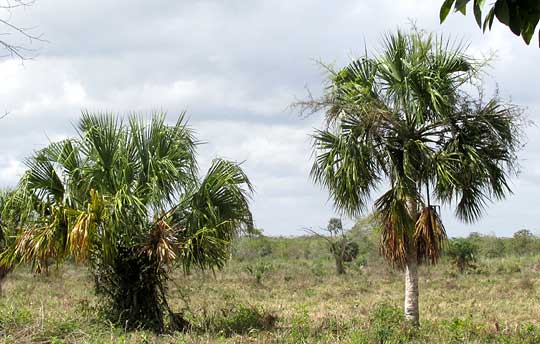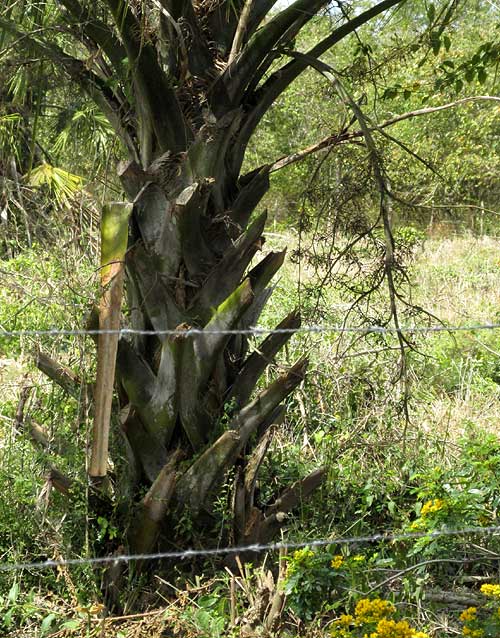Excerpts from Jim Conrad's
Naturalist Newsletter
from the March 8, 2015 Newsletter issued from Río Lagartos, on the Yucatan Peninsula's northern coast (~N21.60°, ~W88.16°), Yucatán state, MÉXICO
MEXICAN PALMETTO
On a birding tour into the ranchland south of town, which was palm- and grass-rich savanna before livestock was introduced, two fan palms stood next to one another, as shown below:

What caught my eye wasn't their different trunk lengths and widths, for this can be explained by age and individual palm tendencies to retain petiole bases of old fronds. What I noticed was that on the palm at the right old flowering clusters, or inflorescences, projected far beyond the fronds, which is the behavior of our abundant Huano Palms, or Thatch Palms, Sabal yapa. However, the palm on the left also has an old inflorescence, but it's much shorter than the fronds, barely visible drooping in the shade on the trunk's right side. A closer look at another such palm's old inflorescence is shown below:

Something else to notice in that picture is that the old petiole bases covering the stem are split at their own bases. Our abundant Huano petiole bases don't split like this. Here we have a different species of the genus Sabal.
CICY, the Centro de Investigación Científica de Yucatán, lists four Sabal species for the Yucatan. Our abundant one is Sabal yapa. Another species, Sabal mauritiiformis, occurs from southern Mexico south to northern South America, but in the Yucatan it appears to be restricted to the rainier southeastern section, plus its inflorescences extend beyond its fronds, so our palm with its short, drooping inflorescence isn't that one.
Sabal gretheriae, endemic to just the Yucatan and possibly found in our area, was recognized only in 1991, and is so similar to the fourth species, the Mexican Palmetto, Sabal mexicana, that some experts regard Sabal gretheriae as just a local variation of Sabal mexicana. Our tree on the left is one of these two taxa, if Sabal gretheriae exists, but which one? Working just with our photos and lacking flowers and seeds, I can't say which species it is. However, Sabal mexicana would be more likely here, plus the inflorescence of Sabal gretheriae is described as strongly ascending, while that of Sabal mexicana is "arcuate," meaning that it arches outward. Our old, drooping inflorescence doesn't seem to have ever strongly ascended. I'm calling our tree SABAL MEXICANA, found in dry lowlands from the Lower Rio Grande Valley of Texas south to Nicaragua. It's one of the most widespread and common of Mexico's palm trees.
Something interesting about Sabal Mexicana's presence in our area is what Scott Zona writes in his 1990 "A Monograph of Sabal (Arecaeae: Coryphoideae)." He says of the species that "Its presence in Yucatán may be attributed to the activities of pre-Columbian peoples." He doesn't regard it as naturally occurring here.
Zona's monograph on Sabal can be downloaded for free at http://www.virtualherbarium.org/PDF%20Files/Zona_Sabal_monogr.PDF